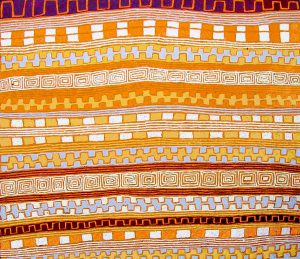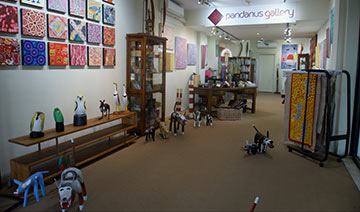Visually Stunning Patrick Tjungurrayi Art For Sale
Pandanus Aboriginal Art includes work by the acclaimed and inspirational Western Desert artist, Patrick Tjungurrayi, one of the most respected Law men in Central Australia and the Western Desert who also was a passionate supporter of the return to traditional home camps program. He was born in the Great Sandy Desert around 1940 and developed a connection with the Balgo mission nearly a thousand klms north along the Canning Stock Route, where he married and was involved in the building program that led to the expansion of the community and rebuilding of the comprehensive Warlayurti Aboriginal Art Centre. He was named one of the top 50 Most Collectable Aboriginal artists published by Australian Art Collector, Jan – March 2005.
Pandanus Aboriginal Art proudly features a wonderful collection of artworks from Indigenous Australia’s most renowned artists, as well as some talented emerging figures. We have a wide collection of paintings, jewellery, artifacts, and carvings available for purchase online and in our Palm Cove gallery, and we are proud to hold a variety of work that we believe truly represents the spirit and essence of Australia’s Indigenous population.
An essential element in our business mission is to facilitate greater understanding of Aboriginal history and culture through the medium of contemporary Aboriginal art, including paintings, sculpture/carving, print making, weaving, textiles and authentic, high quality artifacts.
At first glance, it may seem unrelated to the subject of Aboriginal art that Elanor Roosevelt once famously stated: “Art is a window on the soul”.
Pandanus Gallery viewpoint is that all great art – irrespective of its geographic/ethnic origin and time period – does meet this definition, in a number of possible perspectives. Suffice to say in relation to a sizable proportion of fine Aboriginal art this equally applies as it does to the great Masters of European and Eastern art. In many Aboriginal artists’ perspective, a fundamental belief in the connectivity between all dimensions of life – both animate and inanimate within the natural world – can and do generate similar experiential, emotional outcomes. Not all Aboriginal art meets this criteria, however much of the art of Patrick Tjungurrayi does.
For Aboriginal people, the spiritual realm underpins all aspects of life. The assignment of a totem at conception or through inheritance is one important aspect of spirituality in Aboriginal life – that is often the motivation behind contemporary artworks.
This spiritual ‘identity’ informs most of the great paintings by Patrick Tjungurrayi, often in his depiction of landforms and movements across the landscape/s of the Tingari (Creation characters who formed the land and instituted the Law and important ceremony passed down through the millennia to maintain and sustain the processes of creation over time).
The Art of Tjungurrayi
His paintings are usually structured using contrasting geometric forms and shapes to depict specific landforms, creeks, hills and sacred sites (not verbally identified as such in most cases).
Patrick’s most common colour palette is based on tonal varieties of red, yellow, white and blue that are evident at various times of the day within the landscape and sometimes exaggerated significantly to heighten impact. Together with movement in wavy lines and curves, the combination reflects the secret/sacred activities and travels of the Dreamtime creation characters inspiring the painting.
It is fascinating to see the contrast between Patrick’s paintings in the Papunya Tula idiom compared to his paintings when he is in Balgo, where he uses more traditional dotting and contrasting colour fields. These works are less formally structured along geometric lines but are just as graceful. It is possible Patrick has been influenced in his Balgo paintings by the artworks and styles of his wife Mirriam, Lucy Yukenbarri (sister-in-law) and Elizabeth Nyumi (sister), the latter two being significant painters of great note. It is also interesting that he signs his Balgo paintings with a combination of his and his wife’s names – combining as ‘Patrick Olodoodie’.
Tjungurrayi is himself a dialysis patient and has worked extensively to bring attention to the health issues particularly requiring dialysis support for Indigenous Australians in remote regions and beyond.
Contact Us




